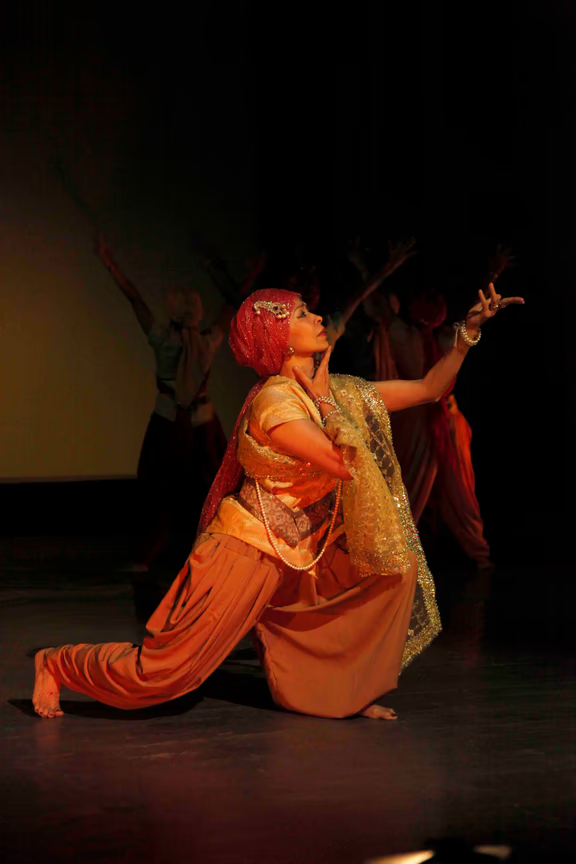Culture abounds - Sambhavami Yueg Yuge – I Am Born From Age to Age
Event reviewBy Bindu
Keywords: Dance, Performances, Bhagavad Gita and Odissi dance

Arjuna (Devasmita) beseeches Krishna
The Bhagavad Gita is a seminal, psycho-spiritual work that is deeply rooted in the collective consciousness of the Indian (Hindu) psyche. Practically every Hindu household, at some point or the other, reverberates with the melodic hymns of the Bhagavad Gita, literally the Song of the Lord. And from the 700 verses, there are few that singularly define the deep-rooted beliefs of the Hindus, such as the concept of the “Avatar”– the incarnation of the Godhead on earth. As verse 8 of chapter 4 states, “For the protection of the good and also for the destruction of the wicked, for the establishment of Dharma, am I born from age to age.”
It is this verse that lent its name, “Sambhavami Yuge Yuge – I Am Born From Age To Age” to the poetic dance-drama choreographed by the sisters Devasmita and Madhumita Pattnaik. Given my Hindu background, I was inexorably drawn to attend the performance. Just as the Gita holds that eternal spiritual truths need to be reinterpreted anew to suit the needs of the time, similarly I was curious to see what innovations and interpretations the two sisters, seasoned Odissi dancers, would bring to bear on their choreography.
Spanning over an hour, the performance was a tour-de-force – boldly conceived and executed with style and grace by Madhumita (as Krishna), Devasmita (as Arjuna) and a troupe of dancers (Odissi students of Madhumita). In keeping with the needs of our contemporary international audience, the Sanskrit hymns that accompanied the performance were also translated as English narrations. This recital in two languages arguably lengthened the event but, for the most part, I felt that this was skilfully handled: often Krishna and Arjuna would enact, with slow dramatic moves, the English narration, while the accompanying dancers would break out in dance in tune to the corresponding poetic Sanskrit hymns.
Secondly, the performance made a clear link to the needs of our times by pointing out that Auroville is like Kurukhshetra (the battle-field which is the backdrop to the Gita) in that each individual soul has to find the meaning of one’s life through one’s field of work. In other words, the Karma Yoga that the Gita espouses will always be of relevance to Auroville. The other major message of the Gitas is that everything that happens is determined in advance by the Will of God. Krishna is asking Arjuna to become a perfect instrument without doubt, without confusion and with complete surrender.
Odissi was the base form of the dance, but I appreciated the innovations on the traditional forms – innovations in the costumes, in the dance sequences, which had echoes of another martial dance form from Odissa called Chhau, and in the use of visual slides as a backdrop. Also, what was quite unusual, and arguably the most spectacular dance sequence, was the moving human sculpture formed by all the dancers, called Vishwarupa, as together they portrayed Krishna, the human charioteer, as the multi-dimensional Godhead. This depiction was further enhanced by the adroit use of lighting, which created a perfect shadow sequence on the back screen.
In a performance of this length, there are naturally some scenes that stand out more than the others. For me, while the lyrical pieces of pure and swift dance sequences were admirable, the depiction of the three “gunas” or qualities of our human nature was skillfully conceived and portrayed both in the movements that were used and in the colour of the costumes of the dancers.
It is hard to be critical of performances in our small community of Auroville, especially if one knows the choreographers as friends as I do. Yet, if I were to give a balanced perspective of the performance, I would suggest that the extras, such as the backdrop slides and props were not fully interwoven with the dance sequences that were unfolding on stage. The additional characters – a sage and his disciples – initially also appeared superfluous but, on reflection, provided a clever way of bracketing the beginning and the end of the performance, just as the Bhagavad Gita is a bracketed text within a much longer epic, the Mahabharata. Overall, I was duly impressed by the creativity of the choreographers who had the courage to conceive and execute a performance of this length, with multiple actors enacting scene after scene with changes in pace that kept the audience engaged.